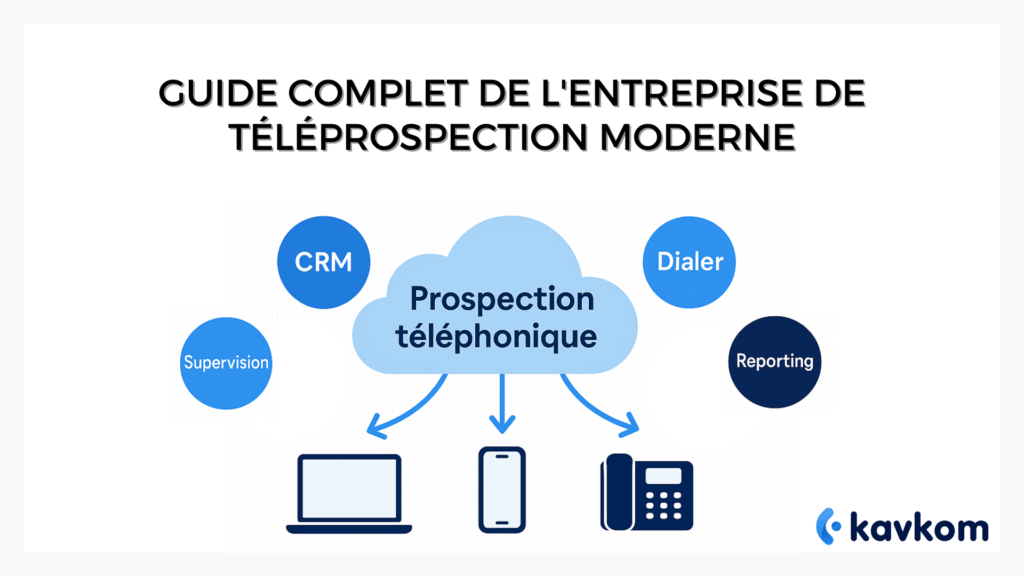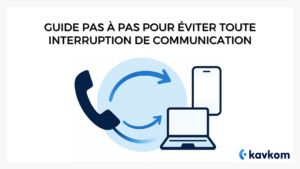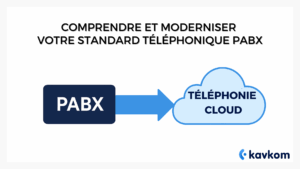In this guide, we’ll show you how to turn this mess into a fluid, high-performance system. We’ll break down what a cold calling business is, what goals it can achieve, what tools to use, and how to build a modern model designed for growth.
Points to remember :
- Traditional methods based on spreadsheets and manual calls quickly show their limits in the face of more flexible and scalable cloud solutions.
- The right tools – cloud telephony, CRM integration, dialers, supervision and reporting – turn prospecting into a structured, productive process.
- Compliance with the legal framework (RGPD, CNIL, consent) is not only an obligation but also a lever for building trust with prospects.
- A modern approach reduces fixed costs, increases agility and delivers a more consistent customer experience.
What is a telemarketing company?
Telemarketing refers to all direct contact with prospective customers by telephone. The aim is not to sell immediately, but to create an initial interaction that opens the door to further sales.
This distinguishes it from telemarketing, which is more focused on the immediate promotion or sale of a product or service. Telemarketing, on the other hand, takes the long view: it aims to qualify, understand needs and prepare the ground.
Real-life use cases
- Making appointments for sales representatives.
- Lead generation via targeted outbound calls.
- Identify opportunities in new B2B markets.
In a nutshell: a cold calling company acts as the armed wing of the sales force. It sorts out the leads, feeds the pipeline and allows the sales force to concentrate on closing.
Objectives of a telephone prospecting campaign
Launching a prospecting campaign without precise objectives is like making a random phone call in the phone book. To be effective, a campaign must aim for measurable results.
The three main objectives
- Get qualified appointments. Every validated appointment is a step towards conversion.
- Increase the number of leads. The fuller the funnel, the greater the chances of closing.
- Improving customer relations. A well-handled call, even an outgoing one, can build trust.
Table: objectives and expected benefits
| Objective | Expected profit | A concrete example |
|---|---|---|
| Qualified appointments | Full business agenda | 20 B2B meetings per month |
| Number of leads | Enriched pipeline | +30% more contacts handled |
| Customer relations | Increased satisfaction | Better recall rate |
These objectives structure the method and provide a framework for measuring success.
Traditional model vs. modern cloud solution
For a long time, telephone prospecting was based on very traditional methods.
Sales staff dialed numbers manually, recorded returns in Excel files and sent reminders to each other by e-mail. The result: a lot of energy spent for little usable follow-up.
Today, the situation is changing with the contact center cloud.
Calls are centralized, statistics are reported in real time, and sales management finally has a global view.
Old model vs. modern cloud
| Criteria | Traditional model | Cloud Contact Center |
|---|---|---|
| Costs | Equipment to be installed, fixed costs | Flexible, no-obligation subscription |
| Flexibility | Difficult to evolve | Add or remove users in just a few clicks |
| Follow-up | Manual spreadsheets, risk of errors | Automated reporting, live KPIs |
| Customer relations | Variable response time | Intelligent routing of incoming calls |
The key tools of a telemarketing company
Moving to the cloud isn’t enough: you also need to choose the right tools.
Each brick plays its part in making prospecting more fluid and your telesales operators more productive.
Cloud telephony and IVR
A cloud telephony system manages incoming calls, queues and voice greetings.
This is the basis for avoiding stray rings and giving a professional image right from the first contact.
In a nutshell: cloud telephony acts like a centralized reception desk. It ensures that every call is answered, even at peak times.
CRM integration
Double entry is the number one enemy of productivity.
When telephony is linked to CRM, each call is automatically connected to the prospect’s file.
As a result, your sales reps know who’s calling, see the call history and can personalize their sales pitch.
Case in point: an agent picks up the phone. The CRM
Dialers and automation
Dialing one number after another may seem trivial… but multiplied by hundreds of calls a day, it’s an enormous waste of time.
Dialers take over: they dial automatically and connect your agents only when a caller picks up.
There are several types:
- Predictive: anticipate pick-ups to keep sales reps in constant conversation.
- Progressive: dials in at the agent’s own pace, practical for more sensitive calls.
- Preview: allows you to consult the prospect’s file before launching the call.
Why automate?
Automating the dialing process saves precious time and avoids repetitive task fatigue. Agents can concentrate on what matters: talking to qualified leads.
Supervision and control
Telemarketing isn’t just about scripts.
It’s also a discipline that requires monitoring and coaching. With supervision tools, a manager can listen to a live call, whisper advice to the agent or intervene if necessary.
Real-time statistics provide a clear picture: number of calls made, average duration, conversion rate. These are all indicators you can use to adjust your strategy.
Supervising isn’t about monitoring. It’s about giving telemarketers the means to progress and maintain the quality of the leads they generate.
Reporting and satisfaction surveys
A campaign without reporting is like driving without a dashboard.
Tracking KPIs lets you know how many leads have been generated, how many appointments have been confirmed and what proportion of prospects actually convert.
Satisfaction surveys complete the picture: they give customers a voice to measure their perceptions.
According to ARCEP, perceived service quality has become a decisive choice criterion in customer relations.
Key indicators to track
| Indicator | Why it’s useful | Example of threshold |
|---|---|---|
| Conversion rates | Measures call efficiency | 15% of leads become appointments |
| Average call duration | Evaluates the relevance of exchanges | 3-5 minutes in B2B |
| Customer satisfaction | Follow the experience | Score > 8/10 on surveys |
Modern solutions for structuring your prospecting
Having a pile of scattered tools doesn’t help to structure prospecting.
One program for telephony, another for CRM, a third for statistics… every sales rep ends up juggling from one window to another.
Today, platforms bring everything together in a single environment. Virtual numbers, predictive dialers, CRM integrations and real-time supervision: prospecting becomes fluid, measurable and scalable.
The core of these solutions, like Kavkom, remains cloud telephony and CRM integration, not complete multi-channel management (SMS, chat, video, etc.).
That’s exactly what Kavkom offers. This 100% cloud solution centralizes telephony, campaigns and supervision, without hardware or commitment.
It equips your in-house teams to manage their calls efficiently, but Kavkom doesn’t do the prospecting for you.
Telemarketing costs: which model to choose?
When it comes to the cost of a telephone prospecting campaign, there are two opposing models.
The first, inherited from the old standards, relies on hardware installed in the company. It requires a physical switchboard, specific handsets, and sometimes even a technician for updates. Added to this are fixed monthly costs, often rigid and difficult to reduce.
The second model, now dominant, is the cloud. Here, no hardware, no long-term commitment. You pay a subscription fee per user, and can scale up or down according to your current needs. If your business slows down in August, you suspend your lines. If you recruit five more sales reps in September, you can equip them in a matter of minutes.
Hardware vs. cloud costs
| Criteria | Hardware model | Cloud model |
|---|---|---|
| Initial investment | Switchboard installation, handsets, cabling | None, online activation |
| Flexibility | Fixed subscription, long-term commitment | Flexible billing, immediate termination |
| Scalability | Adding lines is slow and costly | Add/delete users instantly |
| Management | Dependence on IT and technicians | Quick and easy online administration |
In brief
The cloud saves precious time and keeps costs under control. It’s a logic of on-demand consumption, perfectly suited to companies that want to remain agile.
Legal framework and compliance
Telephone prospecting is a powerful tool, but it’s also governed by strict rules. Respecting these rules is not only an obligation: it’s also a way of building trust with your prospects.
CNIL and RGPD: protecting personal data
In France and Europe, the RGPD requires personal data to be handled with transparency and security. Telephone numbers, call histories or recordings must be protected and accessible only to authorized persons.
According to the CNIL, every prospect must be able to ask to consult, modify or delete his or her information.
Opposition lists and consent
You can’t just call anyone, anytime. Measures such as Bloctel enable individuals to oppose telephone canvassing. Companies must therefore ensure that their prospecting files are compliant, and that the prospects called have not refused.
Quick tip
To avoid any faux pas, keep your databases up to date and clearly inform your prospects of how their data will be used. A simple reminder at the beginning of a call can be enough to establish a climate of trust.
Successful telephone prospecting is always based on a respectful customer experience. By “always listening”, you respect the legal framework while reinforcing your image as a serious partner.
Telemarketing FAQs
What’s the difference between telemarketing and telemarketing?
Telemarketing aims to promote a product or service to a large number of people, often with a view to volume.
Telemarketing, on the other hand, focuses on making qualified contacts. The aim is to identify interested prospects, understand their needs and prepare a sales meeting.
How much does a telephone prospecting campaign cost?
Costs vary according to the size of the team and the model chosen.
With a traditional hardware system, you have to factor in installation, maintenance and fixed subscriptions.
With a cloud solution, you pay only for usage: a monthly subscription per user, with no hidden costs, and the possibility of adjusting your lines according to activity.
How do you measure the quality of the leads you generate?
Quality isn’t just measured in terms of the number of contacts collected.
It’s also measured in terms of conversion: how many leads become appointments? How many appointments lead to a sale? Indicators such as conversion rate or customer satisfaction score are essential for steering your campaigns.
Does cold calling still work in 2025?
Yes, as long as it’s structured and respectful.
A targeted call, made with a good sales pitch and supported by modern tools, remains one of the most direct ways of building a relationship. It’s precisely this human proximity that sets telemarketing apart from other channels.
Conclusion
You’ve seen what defines a cold calling business, the goals it can achieve, the essential tools and the key role of a modern cloud model.
With flexible, regulatory-compliant solutions, you can turn your calls into real opportunities.
Less time wasted, more qualified leads, stronger customer relationships : that’s the promise of well-managed telephone prospecting.
And if you’re looking to take that next step, there are ready-to-use platforms designed for sales teams. With Kavkom, you can try out a modern, agile approach to prospecting, with no commitment or technical constraints.





